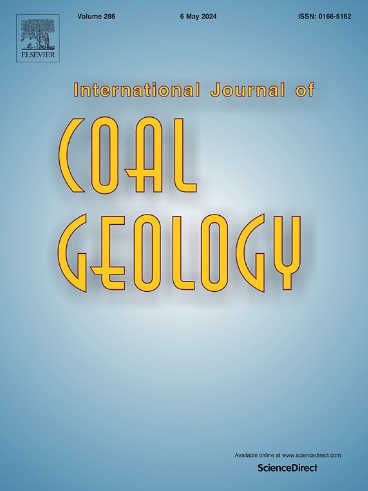Staged evolutionary features of the aromatic structure in high volatile A bituminous coal (hvAb) during gold tube pyrolysis experiments
IF 5.6
2区 工程技术
Q2 ENERGY & FUELS
引用次数: 0
Abstract
Low-temperature pyrolysis of coal is a crucial step in the coal thermal conversion process and involves very complex physical and chemical reactions that can have different effects on the coal's structure. The thermal evolution behavior and transformation mechanism of the coal microstructure are not yet fully understood, which also limits the efficient utilization of coal to a certain extent. The aromatic structural features (including size, molecular ordering, nematic symmetry, stacking, and curvature) of the char produced from low-temperature pyrolysis of high volatile A bituminous coal (hvAb) from the Xutuan coal mine, China, were quantitatively assessed via high-resolution transmission electron microscopy (HRTEM) image processing and analytical techniques. The thermal transformation process and the mechanisms controlling it were explored. The results show that, except for the unexpected slight growth of aromatic sheets at 440 °C, the lower pyrolysis temperature (< 521 °C) contributed weakly to their size growth, whereas at higher temperatures (561–600 °C), it significantly increased their size. The aromatic molecular ordering tended to gradually change in three stages: increasing between 340 and 440 °C, decreasing between 440 and 521 °C and increasing again between 521 and 600 °C. The nematic symmetry strength of aromatic fringes also followed a similar pattern with temperature at different scales. Additionally, in addition to a very minor development trend at 440 °C, the stacking did not significantly change at temperatures below 521 °C but developed appreciably further with increasing temperatures at 561–600 °C; however, the average spacing of the stacks did not appear to be significantly reduced at all temperatures. The curvature of the aromatic sheets also varied in different temperature stages, i.e., initially slightly increasing (340–380 °C), then gradually decreasing (380–480 °C), later increasing again (480–521 °C), and eventually decreasing (521–600 °C). The properties of the chemical composition and structure of the initial coal play important roles in the thermal reaction behavior, and the physical and chemical reactions that dominate at the different temperature stages may be responsible for such wiggly trends in the evolution of the aromatic structure. Notably, the properties of the mesophase (approximately 440 °C) strongly influence the subsequent structural transformation. These findings could provide useful information for the microstructure–property relationships and preparation of coal-based carbon materials.
高挥发性A烟煤(hvAb)金管热解过程中芳香结构的阶段性演化特征
煤的低温热解是煤热转化过程中至关重要的一步,涉及非常复杂的物理和化学反应,对煤的结构有不同的影响。煤微观结构的热演化行为和转变机理尚不完全清楚,这也在一定程度上限制了煤的高效利用。采用高分辨率透射电子显微镜(HRTEM)图像处理和分析技术,对徐团煤矿高挥发性A烟煤(hvAb)低温热解生成的焦的芳香结构特征(包括大小、分子有序度、向列对称性、堆叠和曲率)进行了定量评价。探讨了热转变过程及其控制机理。结果表明,除了在440°C时芳香薄片有意外的轻微生长外,较低的热解温度(<;521°C)对它们的尺寸增长贡献不大,而在更高温度(561 ~ 600°C)下,它显著增加了它们的尺寸。在340 ~ 440℃之间芳香分子的排序呈上升趋势,在440 ~ 521℃之间下降,在521 ~ 600℃之间再次上升。在不同尺度下,芳香条纹的向列对称强度也随温度的变化而变化。此外,除了在440℃时有一个非常小的发展趋势外,在521℃以下的温度下,堆积没有显著变化,但在561 ~ 600℃温度下,随着温度的升高,堆积进一步发展;然而,在所有温度下,堆的平均间距似乎并没有明显减少。芳香薄片的曲率在不同的温度阶段也有不同的变化,即开始时略有增加(340 ~ 380℃),然后逐渐减少(380 ~ 480℃),之后再次增加(480 ~ 521℃),最终减少(521 ~ 600℃)。初始煤的化学组成和结构性质对热反应行为起着重要的作用,在不同温度阶段占主导地位的物理和化学反应可能是导致芳香结构演变的这种扭曲趋势的原因。值得注意的是,中间相(约440°C)的性质强烈影响随后的结构转变。这些发现可为煤基碳材料的微观结构-性能关系和制备提供有用的信息。
本文章由计算机程序翻译,如有差异,请以英文原文为准。
求助全文
约1分钟内获得全文
求助全文
来源期刊

International Journal of Coal Geology
工程技术-地球科学综合
CiteScore
11.00
自引率
14.30%
发文量
145
审稿时长
38 days
期刊介绍:
The International Journal of Coal Geology deals with fundamental and applied aspects of the geology and petrology of coal, oil/gas source rocks and shale gas resources. The journal aims to advance the exploration, exploitation and utilization of these resources, and to stimulate environmental awareness as well as advancement of engineering for effective resource management.
 求助内容:
求助内容: 应助结果提醒方式:
应助结果提醒方式:


